Cell Signaling: Receptors, Pathways, and Nerve Communication
1/82
There's no tags or description
Looks like no tags are added yet.
Name | Mastery | Learn | Test | Matching | Spaced |
|---|
No study sessions yet.
83 Terms
Why is signaling essential for cells?
Cells need to perceive and respond to signals to survive in an ever-changing environment.
What types of stimuli can cells respond to?
Cells can respond to stimuli such as light, sound, taste, smell, hormones, electrical signals, and positional information.
What are the general principles of cell signaling?
1. Signals can act over long or short ranges. 2. A limited set of extracellular signals can produce a variety of cell behaviors. 3. Responses can be fast or slow. 4. Cell-surface receptors relay signals via intracellular pathways. 5. Some proteins act as molecular switches. 6. Receptors fall into three main classes.
How do extracellular signal molecules interact with cells?
Most extracellular signal molecules bind to cell-surface receptors, generating intracellular signaling molecules, while some small or hydrophobic molecules can pass through the plasma membrane and bind to intracellular receptors.

What is the role of acetylcholine in cell signaling?
Acetylcholine can induce different responses in different target cells, such as heart pacemaker cells and salivary gland cells, by binding to similar receptor proteins.
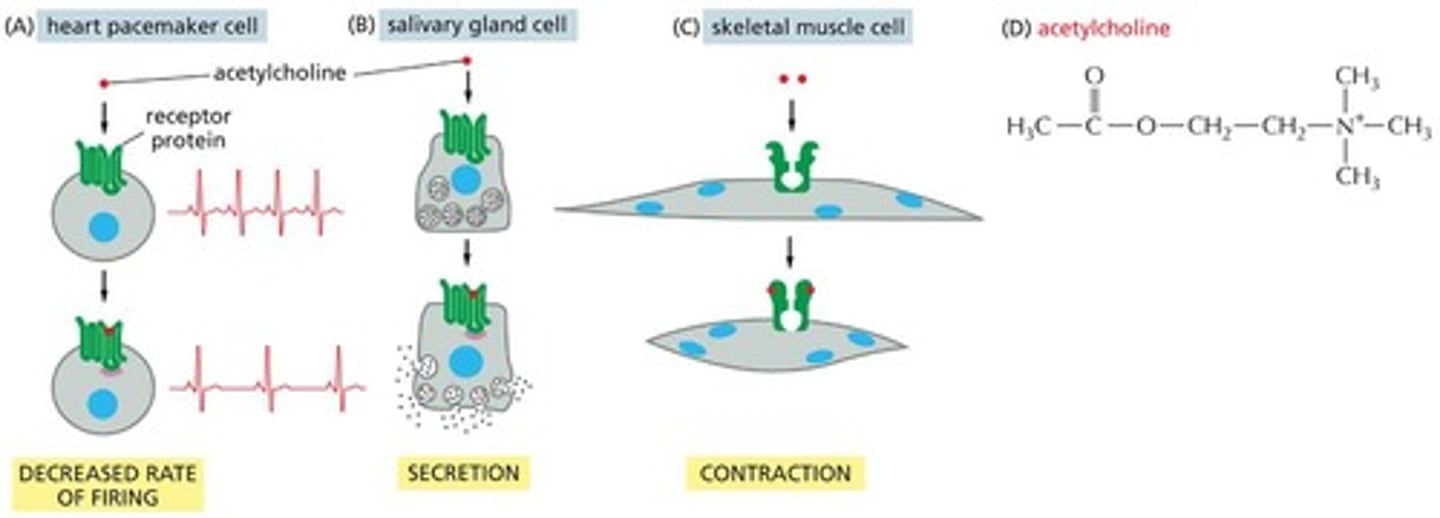
What is required for an animal cell to survive, grow, and differentiate?
Animal cells depend on multiple extracellular signals for survival, growth, division, and differentiation.
What are the four types of signaling methods mentioned?
1. Endocrine signaling (hormones in the bloodstream). 2. Paracrine signaling (local mediators). 3. Neuronal signaling (electrical signals along axons). 4. Contact-dependent signaling (direct cell-to-cell contact).
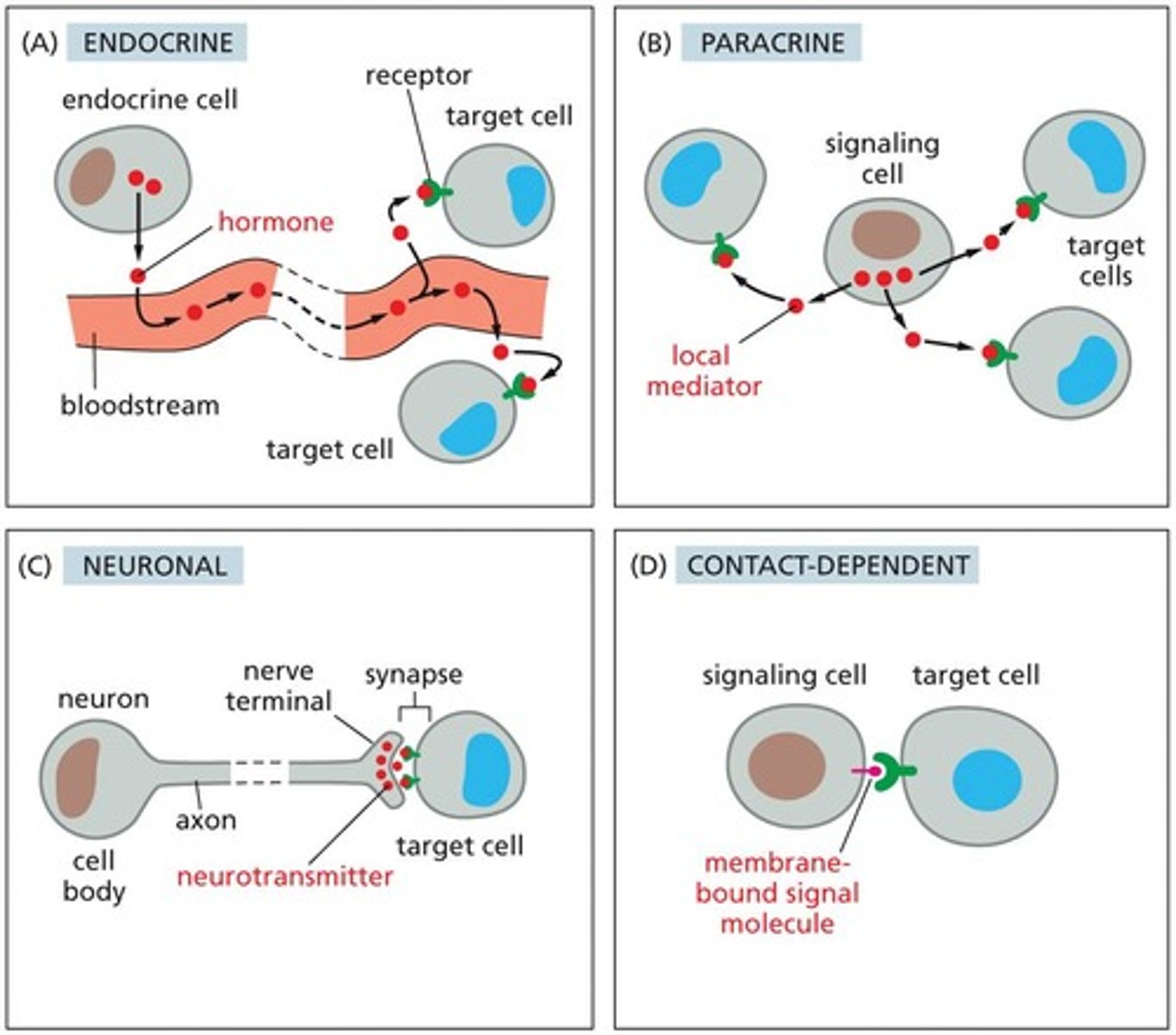
What distinguishes endocrine, paracrine, and neuronal signaling?
The speed and selectivity of signal delivery to their targets.
What determines the speed of a cell's response to a signal?
Responses involving changes in gene expression and protein synthesis occur slowly, while changes in cell movement, secretion, or metabolism can occur quickly.
How do cell-surface receptors relay signals?
Cell-surface receptors activate intracellular signaling pathways that change the behavior of the target cell.
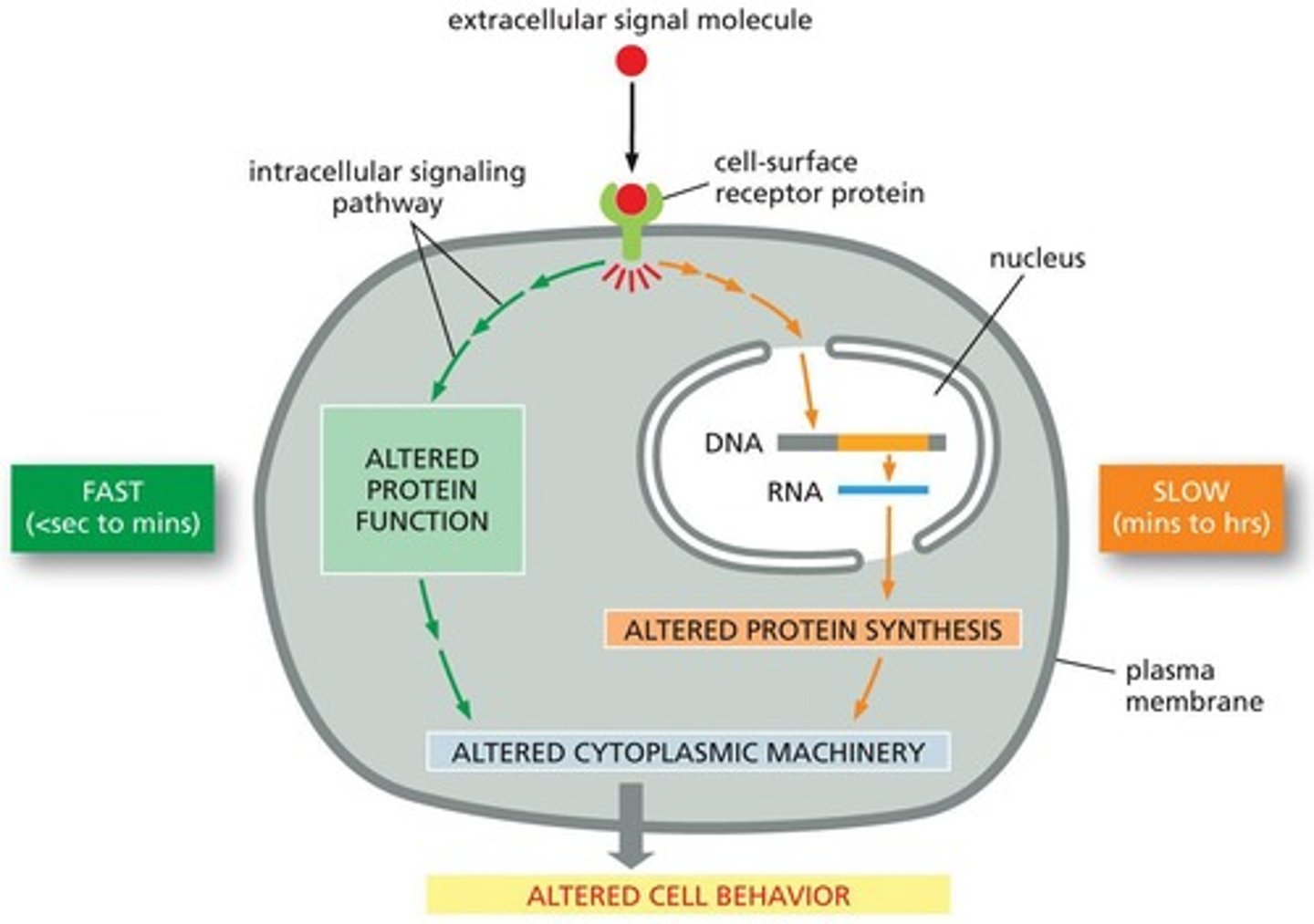
What functions do intracellular signaling proteins serve?
They can relay, amplify, integrate, distribute, and modulate signals, often acting as molecular switches.
What is the significance of scaffold proteins in signaling pathways?
Scaffold proteins hold signaling proteins in close proximity, enhancing activation speed, efficiency, and selectivity.
What happens if a cell is deprived of necessary survival signals?
Most cells undergo apoptosis, a form of programmed cell death.
What is the relationship between extracellular signals and intracellular responses?
Extracellular signals activate intracellular pathways that ultimately alter cell behavior, including metabolism, shape, movement, and gene expression.
What types of receptors are involved in cell signaling?
Cell-surface receptors, which can be classified into three main classes, and intracellular receptors.
What is the role of molecular switches in intracellular signaling?
Molecular switches regulate the activity of signaling proteins, allowing for precise control of cellular responses.
How do different cell types respond to the same signal molecule?
Different cell types have distinct receptor proteins that can evoke different responses to the same signal molecule.
What is the effect of extracellular signals on gene transcription?
Some extracellular signals can regulate gene transcription by binding to intracellular receptors.
What types of changes can occur in a cell due to signaling?
Changes can include altered metabolism, cell shape, movement, and gene expression.
What is the role of protein kinases in switch proteins?
Protein kinases add a phosphate covalently to signaling proteins by transferring a terminal phosphate group from ATP.
How do protein phosphatases function in signaling?
Protein phosphatases remove the phosphate from signaling proteins.
What activates GTP-binding proteins?
GTP-binding proteins are activated when they exchange GDP for GTP.
What happens to GTP-binding proteins after activation?
They switch themselves off by hydrolyzing GTP back to GDP.
What are the three main classes of cell-surface receptors?
Ion-channel-coupled receptors, G-protein-coupled receptors, and enzyme-coupled receptors.
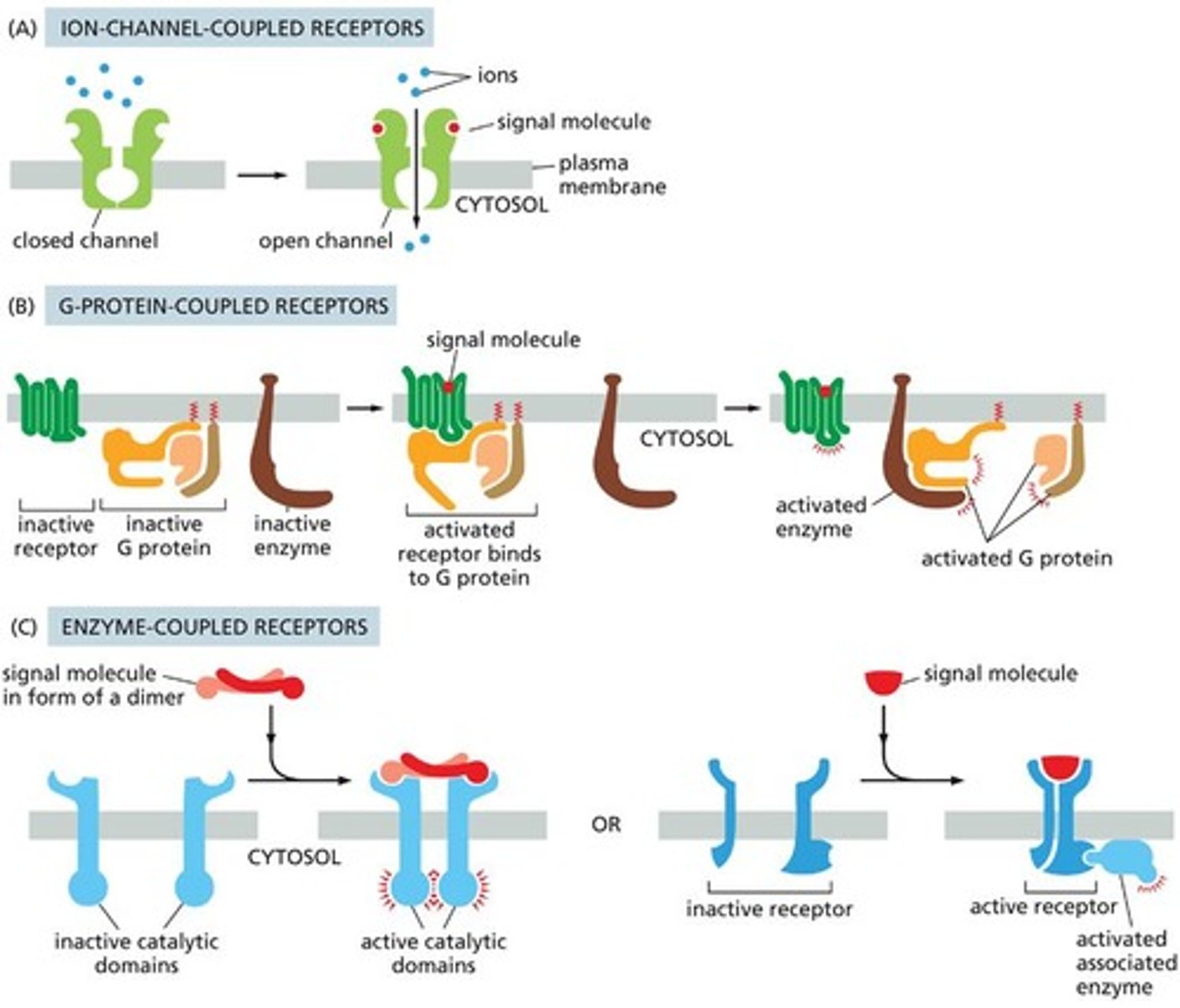
What is the function of ion-channel-coupled receptors?
They open in response to binding an extracellular signal molecule, converting chemical signals into electrical ones.
How do G-protein-coupled receptors (GPCRs) activate G proteins?
Binding of an extracellular signal molecule changes the conformation of the receptor, activating the G protein by exchanging GDP for GTP.
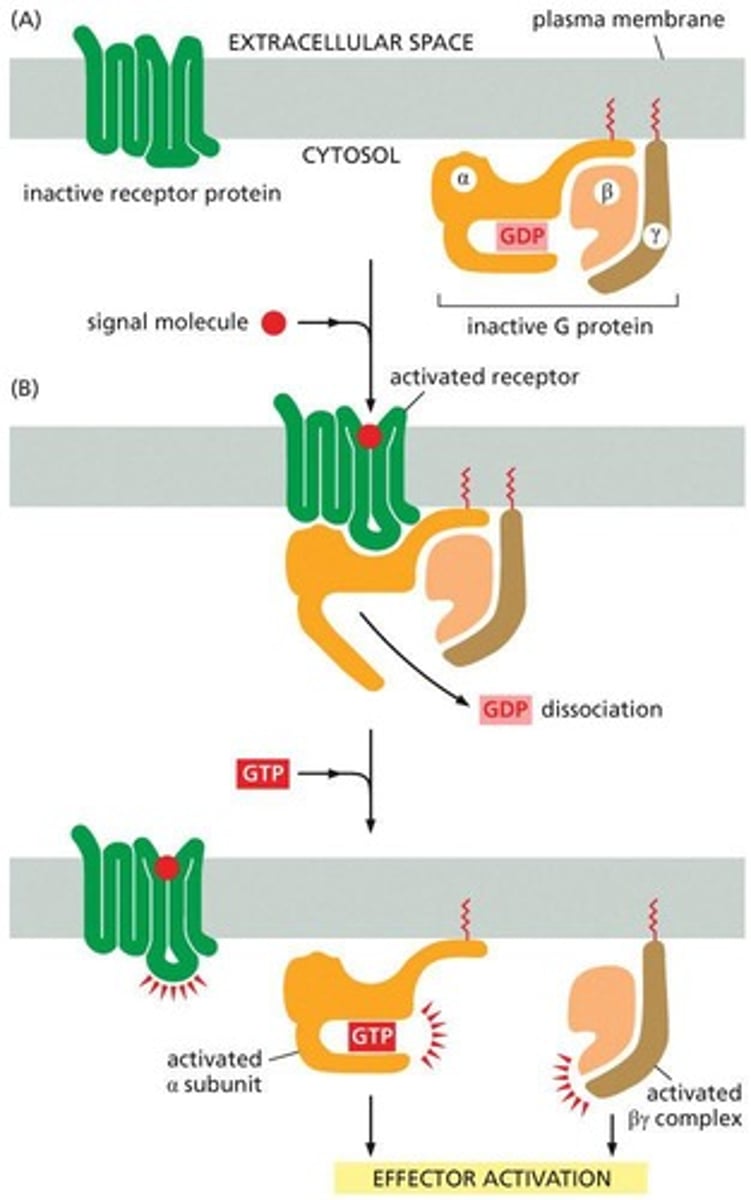
What is the role of cyclic AMP in cell signaling?
Cyclic AMP acts as a second messenger that can activate enzymes and turn on genes.
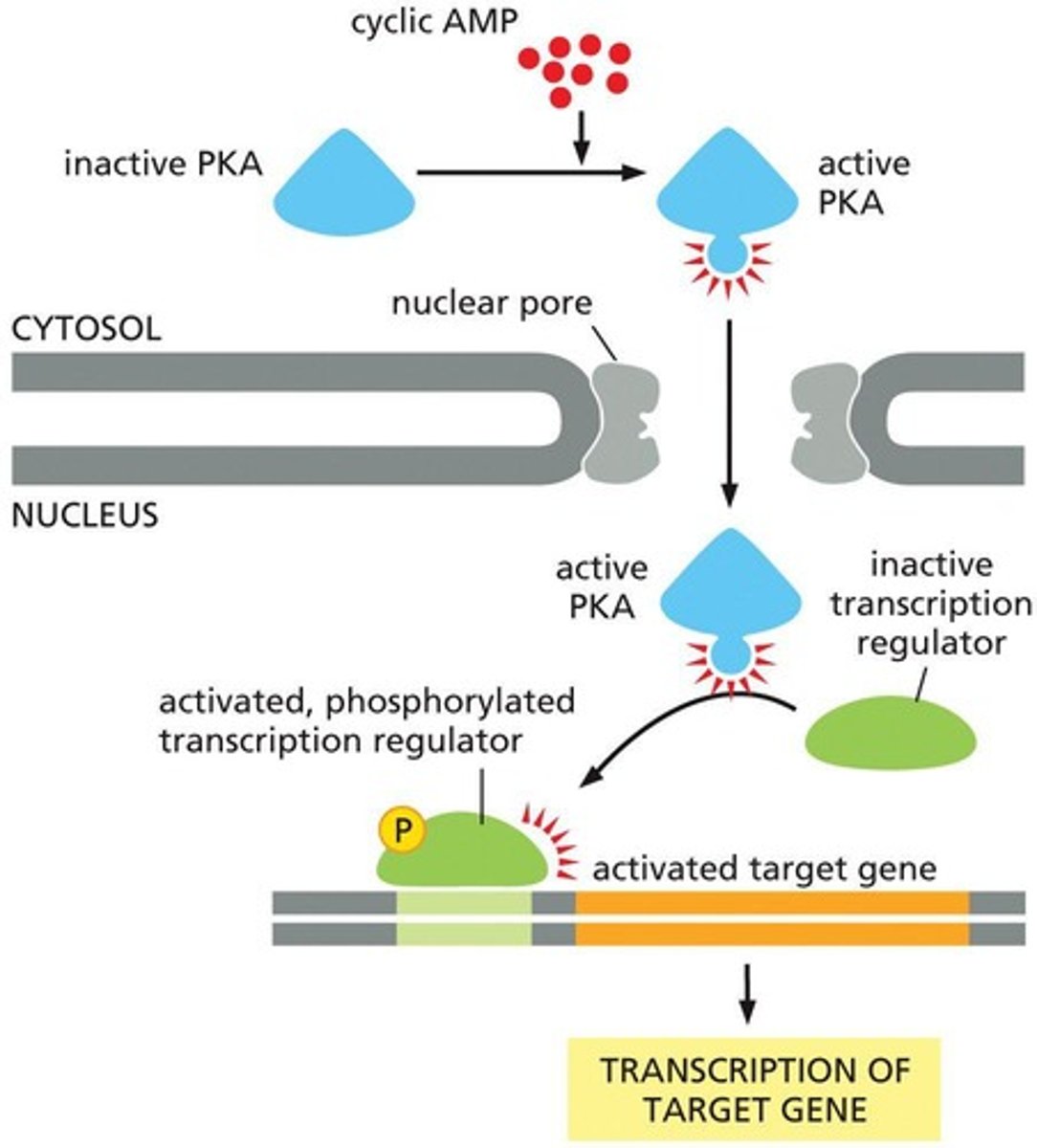
What triggers the rise in intracellular calcium (Ca2+) in the inositol phospholipid pathway?
The hydrolysis of membrane inositol phospholipids by phospholipase C produces inositol 1,4,5-trisphosphate (IP3), which triggers Ca2+ release from the ER.
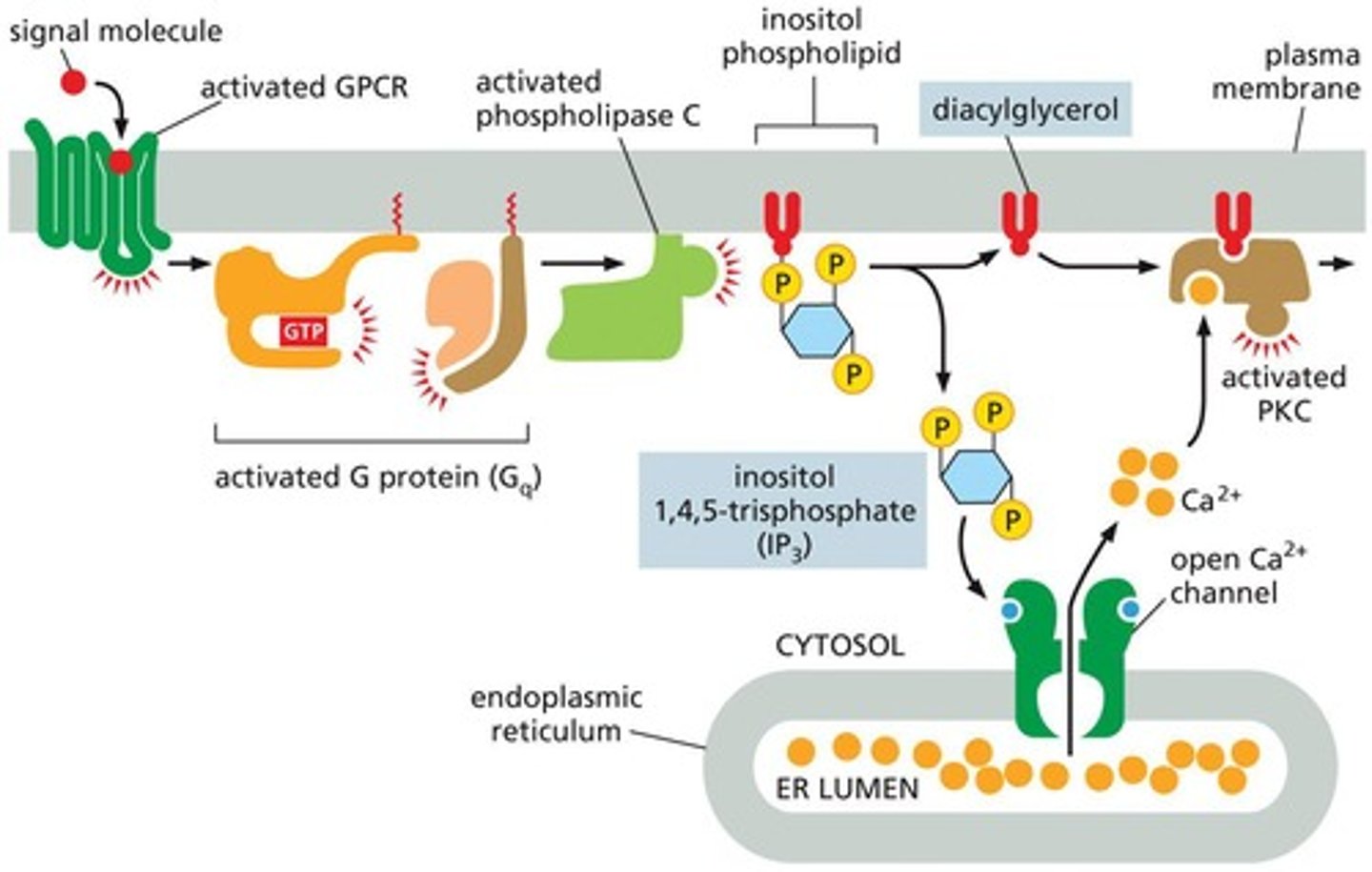
What are the target proteins for activated G proteins?
Target proteins can include adenylyl cyclases, lipases, kinases, and ion channels.
What is the effect of activated Protein Kinase A (PKA) on gene expression?
Activated PKA can enter the nucleus and phosphorylate transcription regulators, stimulating the transcription of target genes.
What happens to the G protein α subunit after it activates a target protein?
The α subunit hydrolyzes its bound GTP to GDP, inactivating itself and reassociating with the βγ complex.
What is the structure of G-protein-coupled receptors?
GPCRs consist of a polypeptide chain that traverses the membrane as seven α helices.
What is the role of ligands in ion-channel-coupled receptors?
Ligands bind directly to the receptors, altering ion flux through the channel.
What is the function of the βγ complex in GPCR signaling?
The βγ complex can interact with target proteins in the plasma membrane, contributing to signaling pathways.
How does the binding of epinephrine affect GPCRs?
Epinephrine binding accelerates heartbeat by activating GPCRs that influence cardiac function.
What are the two messenger molecules produced by phospholipase C?
Inositol 1,4,5-trisphosphate (IP3) and diacylglycerol.
What is the significance of the electrochemical gradient for Ca2+ across the ER membrane?
It causes Ca2+ to rush out of the ER into the cytosol, triggering various biological processes.
What is the main function of enzyme-coupled receptors?
They switch on enzyme activity inside the cell upon binding an extracellular signal molecule.
How do GPCRs achieve speed and sensitivity in signaling?
GPCR-triggered intracellular signaling cascades can achieve astonishing speed, sensitivity, and adaptability.
What is the process of cyclic AMP synthesis?
Cyclic AMP is synthesized from ATP by adenylyl cyclase through a cyclization reaction that removes two phosphate groups.
What is the role of cyclic AMP phosphodiesterase?
It degrades cyclic AMP to AMP, regulating the levels of this second messenger.
What is the outcome of G protein activation?
It activates target proteins for as long as the G protein remains in contact with them.
What is the relationship between GPCRs and G proteins?
GPCRs are coupled to G proteins, which transmit signals from the receptor to target proteins inside the cell.
What role does diacylglycerol play in cell signaling?
Diacylglycerol remains in the plasma membrane and, together with Ca2+, activates protein kinase C (PKC), which phosphorylates intracellular proteins.
What is the function of protein kinase C (PKC)?
PKC phosphorylates a set of intracellular proteins to propagate the signaling pathway.
Which G protein is involved in activating phospholipase C?
The α subunit and the βγ complex of the G protein Gq.
What is calmodulin and its role in calcium signaling?
Calmodulin is a calcium-binding protein that mediates responses to sudden increases in calcium concentration in the cytosol.

Describe the structure of calmodulin.
Calmodulin has a dumbbell shape with two globular ends connected by a long α helix, each globular end containing two Ca2+-binding sites.
How does nitric oxide (NO) affect smooth muscle cells?
NO triggers smooth muscle relaxation by diffusing into adjacent smooth muscle cells and regulating specific proteins.
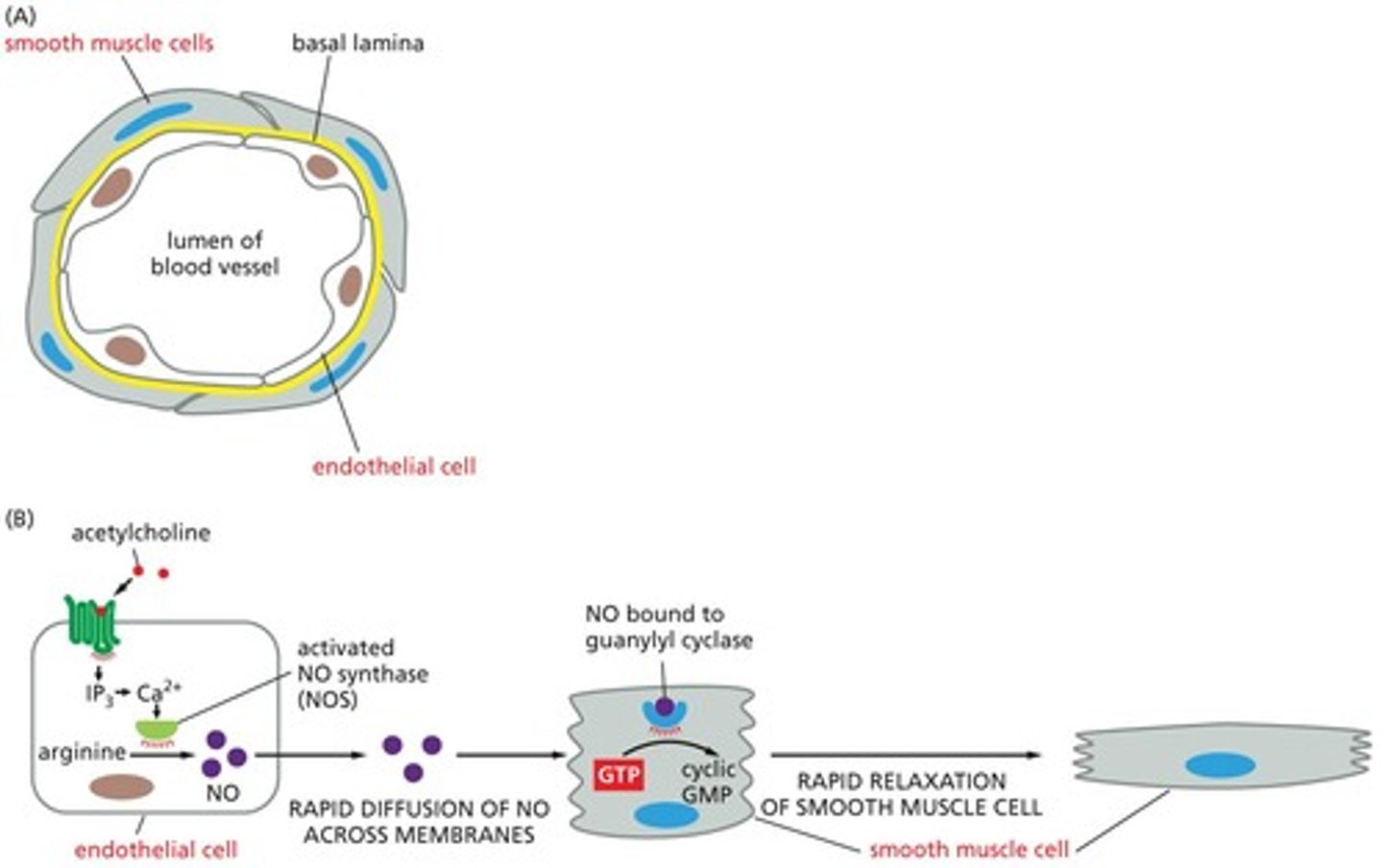
What initiates the production of nitric oxide (NO) in blood vessels?
The neurotransmitter acetylcholine binds to a GPCR on endothelial cells, activating Gq, which triggers Ca2+ release and activates nitric oxide synthase.
What is the role of guanylyl cyclase in smooth muscle relaxation?
Guanylyl cyclase catalyzes the production of cyclic GMP from GTP, leading to rapid relaxation of smooth muscle cells.
What is the function of receptor tyrosine kinases (RTKs)?
RTKs recruit a complex of intracellular signaling proteins and activate pathways such as Ras and PI 3-kinase.
How do RTKs activate intracellular signaling pathways?
Binding of a signal molecule to RTKs causes dimerization, activating their kinase domains to phosphorylate tyrosines on adjacent tails, creating docking sites for signaling proteins.
What is the significance of phosphatidylinositol 3-kinase (PI 3-kinase) in cell signaling?
PI 3-kinase produces lipid docking sites in the plasma membrane that attract signaling proteins, such as Akt.
What happens when an extracellular survival signal activates an RTK?
It recruits and activates PI 3-kinase, which phosphorylates inositol phospholipids, attracting signaling proteins that relay the survival signal.
What are the common components in GPCR and RTK signaling pathways?
Both pathways activate protein kinases that can regulate various cellular processes.
How do some extracellular signal molecules interact with intracellular receptors?
They cross the plasma membrane and bind to intracellular receptors that act as transcription regulators.
What is the role of cortisol in cell signaling?
Cortisol binds to its receptor in the cytosol, activating it to regulate gene transcription by binding to specific DNA sequences.
How do steroid hormones typically function in cells?
They bind to intracellular receptors that can act as transcription regulators, influencing gene expression.
What distinguishes plant signaling strategies from those used by animals?
Plants utilize different receptors and signaling strategies compared to animals.
What is the effect of phosphodiesterase on cGMP signaling?
Phosphodiesterase down-regulates the cGMP signaling pathway, affecting smooth muscle cell dilation.
What is the half-life of Viagra in the body?
Approximately 4 hours.
What is the half-life of Cialis in the body?
Approximately 17.5 hours.
What is the half-life of Levitra in the body?
Approximately 4-6 hours.
What is the role of ethylene in plants?
Ethylene is a plant hormone involved in stress responses, growth, and leaf abscission.
How does ethylene affect gene transcription?
In the absence of ethylene, a receptor activates a protein kinase that promotes the destruction of a transcription regulator, preventing gene transcription. In its presence, the receptor and kinase are inactive, allowing the transcription regulator to stimulate ethylene-responsive gene transcription.
Where is the ethylene receptor located in plant cells?
The ethylene receptor is located in the endoplasmic reticulum.
What type of channels mediate action potentials in nerve cells?
Action potentials are mediated by voltage-gated cation channels.
What is the function of voltage-gated Ca2+ channels in nerve terminals?
They convert an electrical signal into a chemical signal.
What do transmitter-gated ion channels do?
They convert the chemical signal back into an electrical signal in the postsynaptic membrane.
How do psychoactive drugs affect neurotransmitter receptors?
Most psychoactive drugs alter the activity of neurotransmitter receptors.
What is the significance of synaptic signaling?
The complexity of synaptic signaling enables thinking, acting, learning, and remembering.
What is the structure of a typical neuron?
A typical neuron has a cell body, a single axon, and multiple dendrites.
What initiates an action potential in a neuron?
An action potential is triggered by a depolarization of the neuron's plasma membrane to about -40 mV (the threshold potential).
What happens to voltage-gated Na+ channels during an action potential?
They open in response to membrane depolarization, allowing Na+ to flow into the axon, which further depolarizes the membrane.
What occurs after Na+ channels open during an action potential?
Shortly after Na+ channels open, voltage-gated K+ channels open, allowing K+ to flow out of the axon and returning the membrane to its resting potential.
What is the refractory period in nerve cells?
The refractory period is the time during which a membrane cannot produce a second action potential until Na+ channels return to their closed conformation.
What is exocytosis in the context of nerve signaling?
Exocytosis is the process by which synaptic vesicles fuse with the plasma membrane to release neurotransmitters into the synaptic cleft.
How does an action potential propagate along an axon?
An action potential propagates by the sequential opening of Na+ channels along the axon, allowing depolarization to travel forward.
What is the role of Ca2+ in neurotransmitter release?
Increased Ca2+ in the nerve terminal stimulates synaptic vesicles to fuse with the plasma membrane, releasing neurotransmitters.
What is the typical resting membrane potential of a neuron?
The typical resting membrane potential of a neuron is around -60 mV.
What happens to voltage-gated Na+ channels after an action potential?
They become temporarily inactivated and cannot open until the membrane repolarizes.
What is the significance of the squid giant axon in neuroscience?
The squid giant axon is used to study action potentials due to its large diameter, which allows for easier recording of electrical signals.